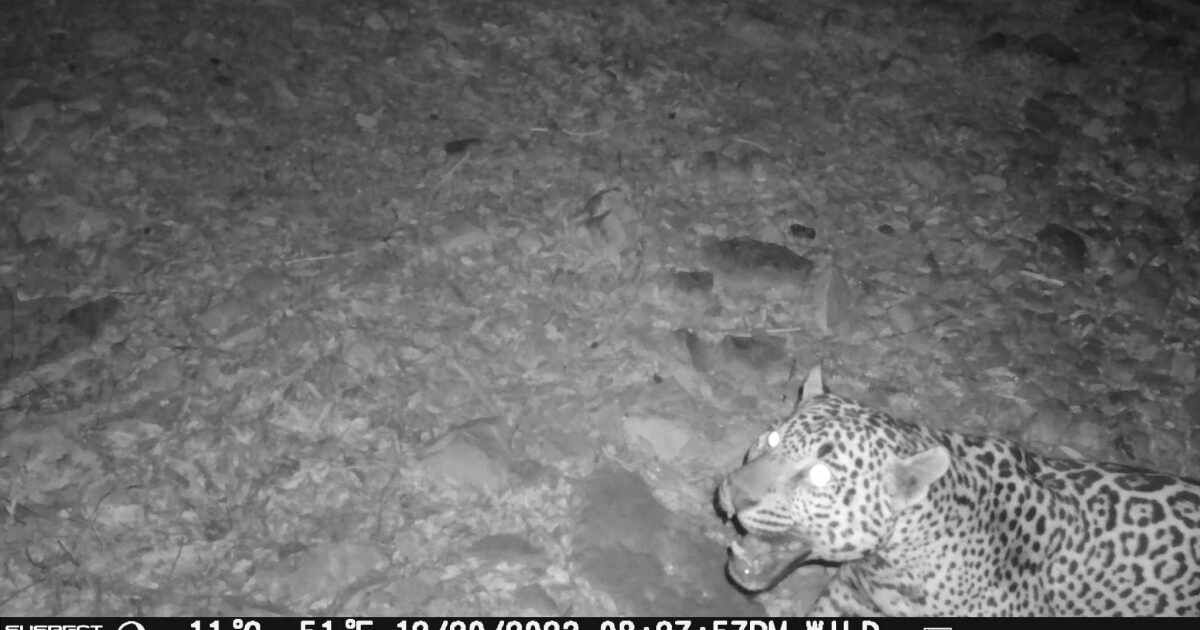For several days last month, photographer Jason Miller recorded a variety of Arizona wild creatures via hidden trail cameras.
On December 11, video cameras captured a cougar sniffing around, followed on December 14 by a mother bear and cub searching for food, two javelina on December 18, and the next day by a ring-tailed cat. sad eyes. They were all recorded by a pair of cameras abandoned in a wooded and rocky area in southern Arizona, next to the border with Mexico.
The images were “stunning but routine” to Miller, 54, originally from nearby Vail, Arizona, whose day job is as a landscaper.
Their most recent findings, however, were exciting.
Miller admitted he “gasped” when he saw what he described as the elusive “holy grail” of big cats, a jaguar, wandering about six feet away from his camera on the night of December 20.
It was around 8:30 pm when the spotted beast appeared and stopped to sniff the cougar's droppings before opening its jaw. The jaguar bared its fangs at the camera as light reflected in its glowing eyes.
“That meant everything to me,” Miller said of the find. “I've been running cameras for a little over five years in southern Arizona and in the deserts hoping that one day I would find a jaguar. “It finally happened.”
Miller's video showed a jaguar in the Huachuca Mountains south of Tucson, wildlife biologists from the Arizona Game and Fish Department confirmed on Monday.
Game and Fish also concluded that the jaguar was not previously photographed or filmed.
Miller's find was more than impressive; It was weird.
Mark Hart, public information officer for Tucson-based Arizona Game and Fish, said the discovery marked the eighth individual jaguar sighted in the wild in the United States since the 1990s.
“Historically, on average, there are three to five jaguars in this state every 10 to 100 years,” Hart said.
One of the last jaguars to capture the imagination of Arizonans was “El Jefe,” last seen near Tucson in 2022. according to AZCentral. Another, named Sombra, was also seen in the Chiricahua Mountains of Arizona that same year.
“There was a lot of press and attention for 'The Boss' and concern when he disappeared,” Hart said.
The cat was first seen in 2011 and was seen regularly until 2015, when Hart said the animal went missing.
The 2022 sighting “relieved a lot of his fans,” Hart said. “El Jefe” is believed to have returned to the northern Mexican state of Sonora, according to Hart.
Although the gender and age of Miller's jaguar are unknown, Hart believes the creature is male.
“So far, all recent jaguar sightings have been of a male,” he said. “The last female documented in the wild dates back to the 1940s.”
The presence of Miller's cat fits a migratory pattern in Arizona, according to Hart.
He said a popular theory put forward by jaguar experts is that the cats showing up in Arizona come from a breeding population in Sonora that has been driven out by other males.
“They have everything they need here in terms of food and space,” he said, “but no females, so eventually they leave.”
Jaguars were once abundant in the southwestern United States, but were driven out by hunters, particularly predator control agents in Arizona as the state grew, Hart said.
Hart noted that Miller's find also highlighted the usefulness of photographic equipment.
“The first five jaguar sightings were made by hunters” who observed the animals in the wild, he said. “These last three come from trail cameras.”
Miller said he was a lifelong bowhunter and retired just two years ago.
Now his duties include naming new bugs. He named his find “Cochise,” the county named after the famous Apache chief in which the discovery occurred.
“I wanted a name that symbolized the Southwest,” Miller said, “and that was 'Cochise.'”












